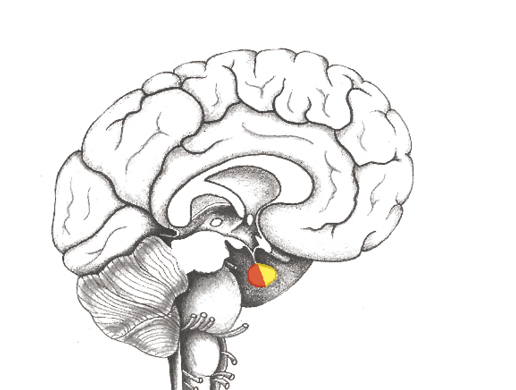In cooperation with Björn, it is splitted on "Disease is Different" into the sections by organ systems and combined with the real cases of our international testimonial / report archive of the related organ system.
HYPOPHYSIS (PITUITARY GLAND)

Pituitary Gland
Anterior Lobe
Chunk conflict due to
nutritional state, body mass, pace of life

Tumor of the milk duct stimulating cells of the adenohypophysis (prolactinoma)1
| Conflict | Probable chunk conflict (see explanations p. 15, 16): One is given cause to worry by superiors (family elders, parents, authorities) that one won’t be able to support/feed their child or family. |
|---|---|
| Examples | ➜ The head of the family earns just enough to support his family, but he loses his job. ➜ A single mother no longer knows how she can support her children.  A 28-year-old, petite woman’s breasts increased in volume and began to secrete milk over the course of a six-month period. Her tumor markers were elevated and a prolactinoma was diagnosed. She told her New Medicine therapist that her breasts began to grow after she learned that her sister was pregnant. When asked, she energetically stressed that she never wanted children – she even broke up with her boyfriend recently. Her therapist asked her if she ever had recurring dreams. She answered yes and related the following nightmare: She has to walk through a room where all kinds of animal corpses are hanging from the ceiling with their mouths glued shut. When she was asked if there had ever been a situation in her life where an animal died, she struggled to answer. A 28-year-old, petite woman’s breasts increased in volume and began to secrete milk over the course of a six-month period. Her tumor markers were elevated and a prolactinoma was diagnosed. She told her New Medicine therapist that her breasts began to grow after she learned that her sister was pregnant. When asked, she energetically stressed that she never wanted children – she even broke up with her boyfriend recently. Her therapist asked her if she ever had recurring dreams. She answered yes and related the following nightmare: She has to walk through a room where all kinds of animal corpses are hanging from the ceiling with their mouths glued shut. When she was asked if there had ever been a situation in her life where an animal died, she struggled to answer. At this point, the therapist decided to do a regression. An image came to the surface: One of her hamsters is lying dead in its cage. She is five years old. She becomes emotional when she hears her father say, “Hopefully you’ll never have children, because you’d let them all starve.” (Her father often said intimidating things because it made him feel important). = Conflict, she is worried that some superior authority will accuse her of not being able to feed her child – This is why she had always ruled out having children! In the same session they performed a healing meditation for the little girl in her past. In the ensuing conversation, the patient had to admit that she wouldn’t have any trouble feeding a child today, because she has a great job. Six months later, the patient called the therapist to thank him. Her tumor markers were down and her breasts had returned to normal. She got back together with her boyfriend and the couple decided to have a child. At the time of the call, she was already looking forward to having a family. (Archive B. Eybl) |
| Conflict-active | Growth of additional, milk-duct stimulating cells = cauliflower-shaped adeno-ca of the hypophysis of secretory quality. Release of more lactotropic hormones (LTH or prolactin) > Because of the proximity to the optic nerve, a tumor, which is too large, can cause visual field defects. Effect in women: Increasing the milk secretion if she is breast-feeding. If she not breast feeding, possible milky discharge from the breast (galactorrhea), libido decrease, absence of ovulation and menstruation (amenorrhea). Effect in men: decreased libido, possibly impotence or infertility. |
| Bio. function | Production of more prolactin so the children and partner can be better nourished with more milk. A higher prolactin level promotes nurturing behavior and reduces sexuality and fertility. (Pregnancy and additional offspring is the last thing that this organism needs.) |
| Repair phase | If fungi or bacteria are present: a tubercular, necrotic degradation of the tumor > normalization of prolactin production > reduction of milk secretion. Inflammation, swelling, headaches, possible double vision. |
| Questions | Symptoms since when? (Conflict before) Is my role as a provider in question? What is stressing me in relation to this? Ancestors: Did any relatives have similar symptoms/life issues? (The deeper cause of today’s problem can be found in unresolved conflicts). |
| Therapy | Determine the conflict and conditioning and, if possible, resolve them in real life if still active. Guiding principles: Realize that one is not alone in taking care of the family. There are relatives, friends, and social institutions that can help care for the family. “There is enough to eat. Everybody will be taken care of.“ Bach flowers (see p. 59): elm, red chestnut, optionally pine. Consider surgery if the tumor creates a problem due to its size (e.g., compression of the optic nerve.) |
Tumor of the adenohypophysis (adeno-ca), gigantism (hypersomnia), enlargement of the extremities (acromegaly)2
| Conflict | Chunk conflict (see explanations p. 15, 16) of being too small. Possibly also: One is “cut down to size” by superiors (parents, authorities) – feels like a “shrimp.” |
|---|---|
| Examples | ➜ A young animal is too small and does not get his share of his mother‘s milk. ➜ A schoolboy is teased because he is the smallest in the class. |
| Conflict-active | Increase in function, growth of a cauliflower-shaped adeno-ca of secretory quality > increased production of the growth hormone somatotropin. Conflict in the growing years > faster growth or gigantism. Conflict in adult years > enlargement of the hands, feet, lower jaw, chin, mouth, nose, sexual organs = acromegaly. Cardiovascular problems often occur. |
| Bio. function | Production of more growth hormones so that the individual grows. |
| Repair phase | Normalization of the somatotropin production. Due to inflammation, the tumor will grow even larger for a short time: swelling > headaches, impaired vision. |
| Therapy | Determine the conflict and conditioning and, if possible, resolve them in real life. Consider surgery, if the size of the tumor causes problems. |
Short stature due to somatotropin deficiency
| Phase | Persistent repair: Reduction of hormone producing tissue > deficiency of somatotropin > delayed development or short stature, insufficient buildup of muscular tissue, too much fatty tissue. |
|---|---|
| Therapy | Omission of the evening meal, athletic activities and sufficient sleep raise the somatotropin level. Basketball, volleyball: In these sports tall people have an advantage > small people come into conflict, which stimulates the somatotropin production > growth. Ingestion of high-quality protein, such as eggs. Linseed oil. Sunbaths. |
Tumor of the adrenal gland stimulating cells (corticotropes)
| Conflict | Chunk conflict (see explanations p. 15, 16) – one has to take a new direction in life because of being pressured/forced by an authority. Undesired influence on one’s own path. |
|---|---|
| Conflict-active | Relatively rare tumor. Growth of additional adrenal gland stimulating cells > increased production of the adrenocorticotrophic hormone (ACTH) > Cushing’s disease (p. 142). |
| Bio. function | With an increased cortisol or aldosterone level, one has a lot of energy. This enables one to find the right way for themselves or to continue on the right path. |
| Repair phase | Normalization of the hormone production, possible breakdown of the tumor by bacteria if present. |
| Therapy | Determine the conflict, conditioning and beliefs and resolve. OP if the tumor becomes too large. |
Tumor of the thyroid stimulating cells (thyreotropes)
| Conflict | Chunk conflict (see explanations p. 15, 16) – one feels compelled to increase the pace of their life by external forces. |
|---|---|
| Conflict-active | Rare tumor. Growth of additional TSH cells > Hyperthyroidism or hypothyroidism . See: p.145. |
| Bio. function | Through increased thyroxine production by the thyroid, the individual is faster. |
| Repair phase | Normalization of the hormone production, possible breakdown of the tumor if bacteria are present. |
| Therapy | Determine the conflict, conditioning and beliefs and resolve. OP if the tumor becomes too large. |
Hormone neutral tumor in the pituitary gland’s anterior lobe
30% of pituitary adenomas produce no hormones (anymore).
One of the SBSs described above has run its course and come to an end.
The conflict has been resolved, the hormone production has returned to normal.
Abnormally short stature – dwarfism
If you can rule out these causes: Under or insufficient nourishment, vitamin deficiency (vitamin D), disturbances in absorbing nourishment (see colon), chemo-poisoning, radiation damage, etc., then the following causes may come into consideration:
• Territorial conflict constellation(s) (cerebral cortex) during the growth phase: simultaneously active Hamer foci on the right and left in the territorial areas bring about – in addition to physical changes – a cessation or delay in physical and psychic maturation (= retardation). Indicators: thin appearance, narrow shoulders, little muscle, late ovulation and/or late sexual maturation, so-called “baby face,” (see: p.385 and literature from Dr. Hamer).
• SBS of the bones during the growth phase: long lasting, active, generalized self-esteem conflict – limitation of the bone metabolism and bone growth during the persistent conflict activity (see: p.353). Signs: anemia, bone and joint pain.
• Testicles – conflict activity during the growth phase: demise (necrosis) of testicular tissue, decrease in testosterone production due to persistent conflict activity > lack of drive, slowing of muscle and body growth (see: p.311).
• Pituitary gland – persistent repair during the growth phase (see: p.139).
All experience reports on the organ system “Hypophysis (Pituitary Gland)” from the International Report Archive:





